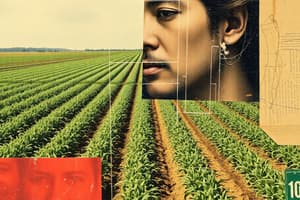Podcast
Questions and Answers
What is the primary basis for botanical classification of plants?
What is the primary basis for botanical classification of plants?
- Morphological characteristics
- Phylogenetic relationship (correct)
- Geographical distribution
- Ecological niche
Which of the following is NOT one of the four divisions of the plant kingdom identified by Eichler?
Which of the following is NOT one of the four divisions of the plant kingdom identified by Eichler?
- Angiosperms (correct)
- Pteridophyta
- Thallophyta
- Bryophyta
Which group is included in the Spermatophyta division?
Which group is included in the Spermatophyta division?
- Fungi
- Mosses
- Ferns
- Seed-bearing plants (correct)
Which category of plants does NOT have true roots or flowers?
Which category of plants does NOT have true roots or flowers?
How many divisions of the plant kingdom have modern taxonomists classified?
How many divisions of the plant kingdom have modern taxonomists classified?
Which of the following families is known for having plants that primarily exhibit a 4-merous flower structure?
Which of the following families is known for having plants that primarily exhibit a 4-merous flower structure?
Which example belongs to the Liliaceae family?
Which example belongs to the Liliaceae family?
What type of growth habits are predominantly associated with the Orchidaceae family?
What type of growth habits are predominantly associated with the Orchidaceae family?
Which family includes significant garden crops like cabbage and broccoli?
Which family includes significant garden crops like cabbage and broccoli?
Which family is noted for containing a serious weed pest known as triangular-stemmed nutgrass?
Which family is noted for containing a serious weed pest known as triangular-stemmed nutgrass?
Flashcards
Cucurbitaceae Family
Cucurbitaceae Family
A plant family with over 550 species, mostly vines, often known as the gourd family.
Brassicaceae Family
Brassicaceae Family
A large plant family with over 3200 species, known as crucifers; common garden crops like cabbage and broccoli.
Apiaceae Family
Apiaceae Family
A plant family with over 2500 species; commonly used as herbs or vegetables, having compound umbels in flower arrangements.
Liliaceae Family
Liliaceae Family
Signup and view all the flashcards
Orchidaceae Family
Orchidaceae Family
Signup and view all the flashcards
Botanical Classification
Botanical Classification
Signup and view all the flashcards
Thallophyta
Thallophyta
Signup and view all the flashcards
Bryophyta
Bryophyta
Signup and view all the flashcards
Pteridophyta
Pteridophyta
Signup and view all the flashcards
Spermatophyta
Spermatophyta
Signup and view all the flashcards
Study Notes
Crop Production as a Science, Art, and Business
- Modern crop production is a scientific process, combining principles from chemistry, mathematics, physics, physiology, meteorology, and plant breeding.
- Crop science involves the observation, classification, and knowledge of cultivated crops to optimize production.
- Agronomy is the management of field crops and soils, drawing from Greek roots.
- Horticulture involves cultivating plants in enclosed spaces, distinct from field crops. Horticultural products are often consumed fresh, are subjectively rated, and have higher prices per unit. Agronomic products are usually processed, have lower prices per unit, and are typically consumed by animals.
- Crop production is also an art, focusing on aesthetic qualities of plants (horticulture) and maximizing output and profit (business).
- Agricultural research in the Philippines involves state colleges, the Department of Agriculture, and national commodity research centers.
Botanical Classification
- Botanical classification is a method for classifying plants based on evolutionary relationships.
- Approximately 300,000 plant species are identified.
- Taxonomy is the dynamic study of plant classification, constantly updated with new knowledge.
- The plant kingdom has 28 divisions. Four common divisions include Thallophyta, Bryophyta, Pteridophyta, and Spermatophyta.
- Spermatophyta further divides into Gymnosperms and Angiosperms; Angiosperms include Monocotyledons and Dicotyledons.
Agronomic Classification
- Cereal crops are grasses cultivated for edible seeds (like wheat, rye, oats, barley, rice, and maize).
- Pasture and forage crops are used for feed.
- Root crops are grown for their edible roots.
- Tuber crops have thickened underground stems.
- Fiber crops provide fibers.
- Sugar crops yield sugar.
Horticultural Classification
- Horticultural plants include fruits, vegetables, and other plants grown for aesthetic or culinary value.
- Plant classification focuses on characteristics like leaf retention (evergreen or deciduous), response to day length (short-day, long-day, or day-neutral), or habit (herbaceous, shrub, or tree).
Special Purpose Classification
- Categories of crops include green manure (legumes), silage, and cover crops for soil improvements and animal feeds.
- Other categories include trap crops to protect against pests, companion crops for mutual benefits, and catch crops to fill gaps in growing seasons.
Studying That Suits You
Use AI to generate personalized quizzes and flashcards to suit your learning preferences.




